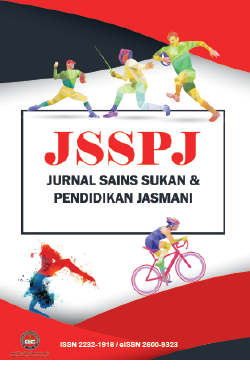Effects of Self-Modelling Video Imagery Interventions on Futsal Players Performances
DOI:
https://doi.org/10.37134/jsspj.vol10.2.10.2021Keywords:
self-modelling, video imagery, futsal performanceAbstract
This study aim to investigate the effectiveness of self-modelling video imagery training (delivered using iPod Touch) on open skills among highly competitive futsal players throughout a competition season. Four male futsal players participated in a single-case ABAB study design for four months. Participants’ performances of four skills (passing, receiving, dribbling, shooting), using hand notational video analysis were examined. Self-modelling video imagery training was customized to focus on the two weakest skills for each participant. The results using visual inspection and split middle technique analysis of individual graphs indicated improvement in performance of all targeted skills all participants during the intervention phases (B1, B2) compared to baseline phases (A1, A2). In conclusion, the self-modelling video imagery was found to beneficial, specifically improving performance of futsal skills in actual games in a season. The used of IPod as technology device to delivering self-modelling video imagery was found to be useful to enhance futsal players’ performances.
Downloads
References
Barzouka, K., Bergeles, N., & Hatziharistos, D. (2007). Effect of simultaneous model observation and self-modeling of volleyball skill acquisition. Perceptual and Motor Skills, 104, 32-42. doi: 10.2466/pms.104.1.32-42.
Blair, A., Hall, C. R., & Leyshon, G. (1993). Imagery effects on the performance of skilled and novice soccer players. Journal of Sports Sciences, 11, 95-101. DOI: 10.1080/02640419308729971.
Dowrick, P. W., & Dove, C. (1980). The use of self-modeling to improve the swimming performance of spina bifida children. Journal of Applied Behavior Analysis, 13(1), 51-56. doi: 10.1901/jaba.1980.13-51.
Holmes, P., & Calmels, C. (2008). A neuroscientific review of imagery and observation use in sport. Journal of Motor Behavior, 40(5), 433-445. DOI: 10.3200/JMBR.40.5.433-445.
Ram, N., Riggs, S. M., Skaling, S., Landers, D. M., & McCullagh, P. (2007). A comparison of modelling and imagery in the acquisition and retention of motor skills. Journal of Sports Science, 25(5), 587-597. https://doi.org/10.1080/02640410600947132.
Kazdin, A. E. (2011). Single-case research designs methods for clinical and applied settings (2 ed.). New York: Oxford University Press Inc.
Khan, T. K. A., Karim, Z. A., & Sato, N. (2019). Self-Talk Intervention Using Video –Imagery: Effects on Under 19 State Soccer Players’ Anaerobic Performance. International Journal of Academic Research in Business and Social Sciences, 9(7), 297–306. http://dx.doi.org/10.6007/IJARBSS/v9-i7/6118.
Khan, T. K. A., Abd Malek, N. F., Ishak, A., & Mohamad, N. H. (2020). Effects of Imagery and Video Modelling on Self-Efficacy during Resistance Exercise. International Journal of Innovative Technology and Exploring Engineering. 9 (1), 2433-2435. DOI: 10.35940/ijitee.A4431.119119.
Khan, T. K. A., T. Morris & D. Marchant. (2017). Portable Devices for Delivering Imagery and Modelling Interventions: Effects On Netball Players’ Adherence, Shooting Performance and Self-efficacy. Journal of Fundamental and Applied Sciences. 9(6S), 1334-1345. DOI: 10.4314/jfas.v9i6s.98.
Khan, T. K. A., T. Morris & D. Marchant. (2015). Portable Devices for Delivering Imagery and Modelling Among Netball Players: A Qualitative Study. Journal of Sports Science and Physical Education, Malaysia 3(2), 50-64. https://ejournal.upsi.edu.my/index.php/JSSPJ/article/view/608.
Lao, S.-A., Furlonger, B. E., Moore, D. W., & Busacca, M. (2016). Learning to Swim Using Video Modelling and Video Feedback within a Self-Management Program. Australian Journal of Adult Learning, 56(1), 52–68. https://files.eric.ed.gov/fulltext/EJ1097542.pdf.
Lauer, E. E., Martin, S. B., & Zakrajsek, R. A. (2019). iSCORE: Using Technology and Imagery to Enhance Performance of Closed Motor Skills. Strategies (08924562),32(3),19–24. https://doi.org/10.1080/08924562.2019.1584068.
Steel, K. A., Anderson, D. I., Smith, C. A., Ellem, E., Liu, K. P. Y., Morrison, A., Dune, T., & Fairley, L. H. (2021). Potential Value of Customized Video Self-Modelling for Motor Skill Learning in Individuals with Cerebral Palsy: A Case-Study Approach. Perceptual & Motor Skills, 128(4), 1464–1484. DOI: 10.1177/00315125211012810.





